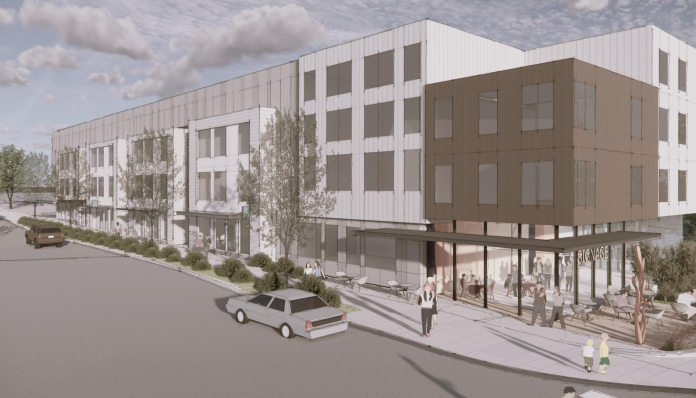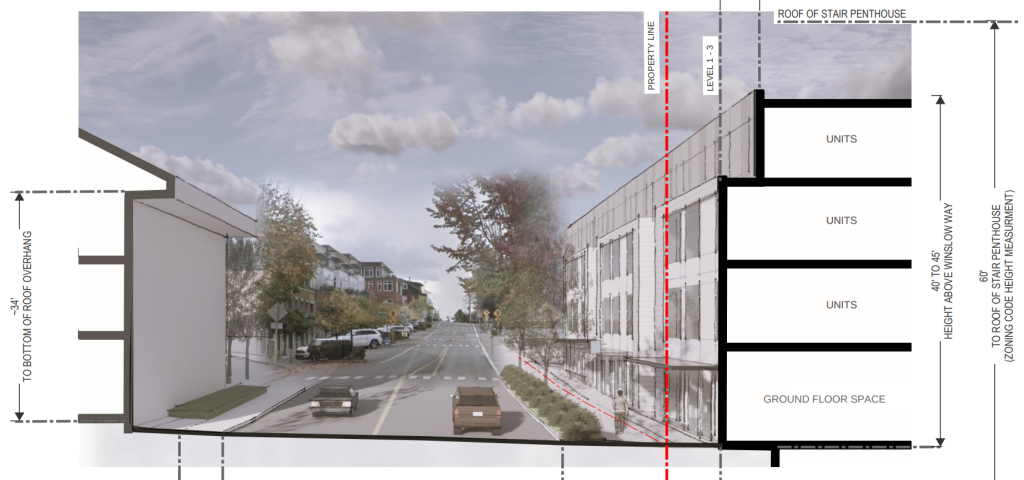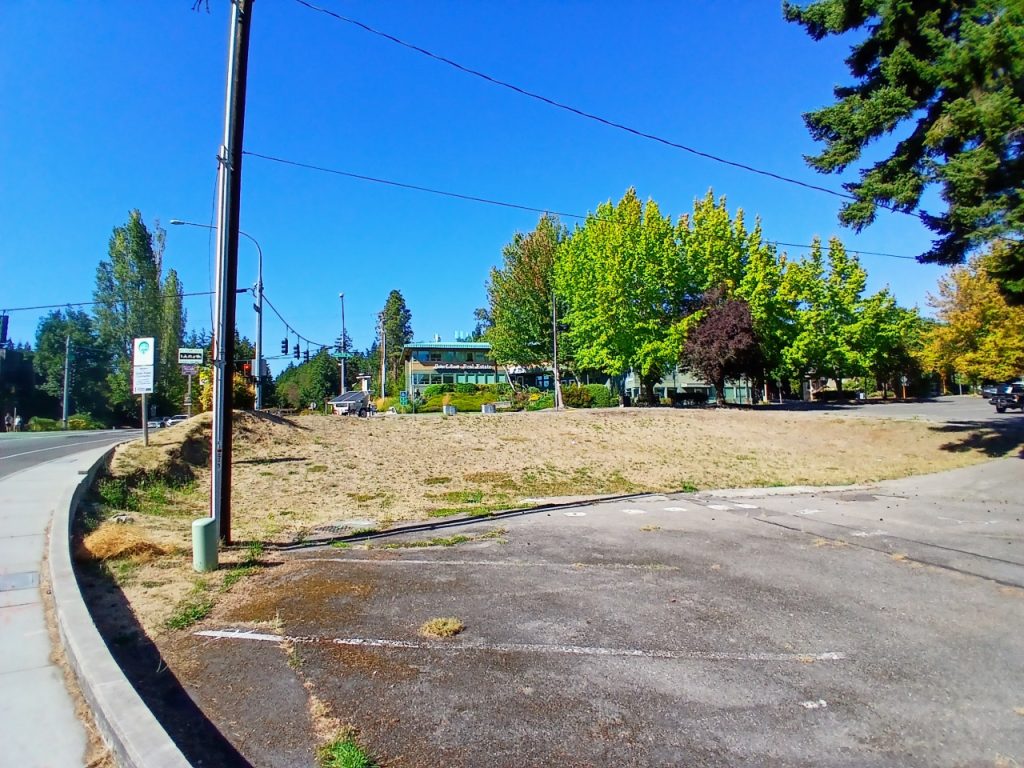
By a 6-1 vote Tuesday, the Bainbridge Island City Council recommended that a 92-unit affordable housing project planned near the state ferry terminal be scaled back by around 25%, in response to criticism of the building’s potential height and number of planned parking spaces. The project, set to go in on the site of a former police station that’s currently a vacant lot, faces an October deadline to apply for funding from the state’s housing trust fund.
The city council has been planning an affordable housing project at the 625 Winslow Way site since 2022, and unanimously approved a development agreement with the Low Income Housing Institute (LIHI) this past May to build and operate it via a long-term ground lease. But the project still needs approval to exceed the existing development standards on the site, and the Bainbridge Island planning commission just last week voted against consideration of an ordinance that would have allowed the 92-unit design to move forward.
The idea to scale back to approximately 70 units came from LIHI, which is among the largest providers of low-income housing in the region. Pushback prompted the nonprofit to look for a way to stay within the existing 45-foot height limit and provide something closer to Bainbridge Island’s current requirement of one parking stall for every unit, without including a massive parking structure. That’s in spite of the fact that the city initially solicited non-profit partners to build 100 units, with LIHI developing the 92-unit design in order to provide more family-sized units on the odd-sized lot.
And it’s also in spite of the fact that LIHI’s original proposal was already set to meet the existing height limit directly along Winslow Way, with the taller sections of the building less visible. Many cities in the region exclude the height of roof access structures from average building height, but not Bainbridge Island.

The idea of a smaller building likely won’t appease many of the project’s critics — including those looking to “Save the Corner” and build some type of civic amenity on the site instead. Nonetheless, the majority of councilmembers seemed eager to grab onto a compromise measure that would address some of the community concerns they’d been hearing. Only Councilmember Leslie Schneider opposed the motion.
“I hear what we lose by reducing the number of units,” Deputy Mayor John Quitslund said ahead of the vote. “At the same time, I think we are gaining a much broader acceptance and some possibility for more elegance in the building’s design, and that is important to me.”
“I actually think that if we scale this down, so that it can fit better on the site, and if we have adequate parking, we are pleasing the people who are going to live there,” Councilmember Kirsten Hytopoulos said. “It doesn’t look good. It looks like affordable housing, so I think people will be prouder to live there if it’s something that’s not an eyesore.”
Hytopoulos, who has been the 92-unit proposal’s biggest critic on the council, chastised those who painted Bainbridge Islanders raising concerns as being opposed to affordable housing.
“I think I feel really insulted as a community member, if I had to continue to be lectured on whether we need affordable housing,” Hytopoulos said. “Everybody in this community knows we really, really need it, that we have a huge deficit, that there are 50 reasons it’s good for us, individually and as a community. So it’s a straw man argument at this point, and it’s kind of bullying to the community to say, if you’re if you think it should be 70 units instead of 100, if you think there should be one parking stall per unit that somehow you don’t really understand the affordable housing crisis, and I think we all do.”
Councilmember Joe Deets told his colleagues that he sees scaling back the building as a path to building more affordable housing projects throughout Bainbridge Island.
“Yes, we lose 20 units. Perhaps it makes us more or less competitive, but 70 is better than nothing,” Deets said. “And not only that, remember, folks, this is not the end game. This isn’t like we do this and we’re done. Okay? We need to do this project. We need community buy-in to do it. I’m stating a strategy out loud here. If this is acceptable to the community, we can do more projects.”

Schneider, the only dissenting vote, noted that the number of units that the council is looking to cut would represent a sizable affordable housing project elsewhere.
“We just treasure the affordable housing projects that give us 20 units right now, and they are massively difficult to build,” Schneider said, citing smaller scale projects built by Housing Resources Bainbridge. “These are really hard projects to do, and I don’t know how many more opportunities we’re going to have to do more of them. We’re losing 20 units off of a large place.”
Councilmember Brenda Fantroy-Johnson, who ultimately voted for the motion, also pushed back on the idea of shrinking the project.
“When we look on the wall, and it says what our priorities are, and it says climate, and we’re haggling over how many parking spaces for people to drive around and pollute the air, and we’re talking about affordable housing, but we’re going to chop off the top floor and have less people who can move in,” Fantroy-Johnson said.
She noted the significant portion of Bainbridge Island workers who have to commute from elsewhere in Kitsap County.
“It’s a problem of how we want to look: do we want to look good or do we want to do good,” Fantroy-Johnson said. “And I get worried that we forget that we have to make the hard decisions up here.”
LIHI faces a fairly tight turnaround time to fully redesign their project in response to Tuesday’s vote, with the nonprofit aiming to receive council approval on a zoning change for this site ahead of an October 16 deadline to submit a funding request to the state’s housing trust fund.
“We appreciate leadership from City officials to find the best pathway to build as many affordable homes as possible on Bainbridge,” Jon Grant, LIHI’s Chief Strategy Officer, told The Urbanist following the vote. “LIHI will make every effort to ensure the final building design reflects community input, as we know how desperately working families and seniors need a home they can afford.”
Ryan Packer has been writing for The Urbanist since 2015, and currently reports full-time as Contributing Editor. Their beats are transportation, land use, public space, traffic safety, and obscure community meetings. Packer has also reported for other regional outlets including BikePortland, Seattle Met, and PubliCola. They live in the Capitol Hill neighborhood of Seattle.

